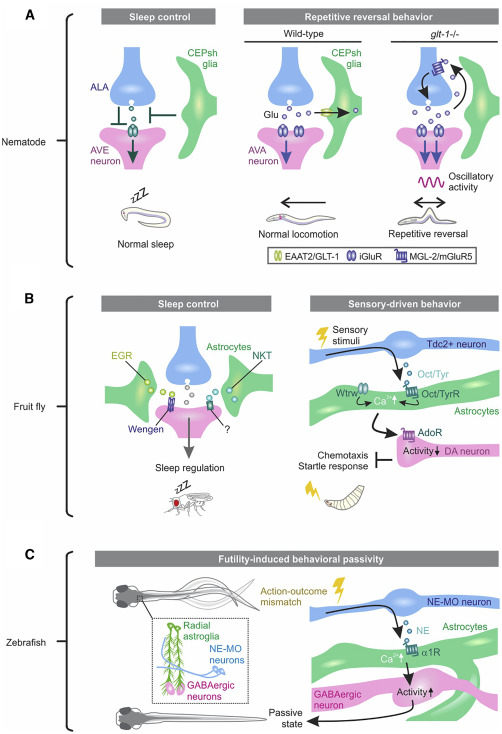Fig. 2 (A) Nematode CEPsh glia are required for normal sleep and locomotion. Left: the oscillatory activity of AVE neurons correlates with head retraction of the worm and regulates locomotion. ALA neurons are active during sleep and synaptically inhibit AVE. The working model from ablation experiments suggests that CEPsh glia tune the ALA-AVE synapse in proper behavioral state transition from wakefulness to sleep. Right: AVA neurons are a major class of interneurons driving backward locomotion. CEPsh glia take up glutamate (Glu) from the synaptic cleft at excitatory synapses onto AVA. Deletion of the glutamate transporter GLT-1 from CEPsh glia results in spillover of Glu from the synapses, activating presynaptic mGluR5 to cause repetitive excitation of AVA and reversal in worm locomotion. (B) Fly astrocytes regulate sleep and sensory-driven behavior. Left: the Drosophila TNF-α homolog Eiger (EGR), expressed in fly astrocyte-like cells (green), acts on Wengen, a receptor of EGR on neurons to regulate normal sleep. An astrocyte-enriched small secreted immunoglobulin (Ig)-domain protein, Noktochor (NKT), exhibits reduction and fragmentation in night sleep but not in day sleep. Right: upon sensory stimuli, Tdc2-expressing neurons release the neuromodulator tyramine (Tyr) or octopamine (Oct), the invertebrate analogs of NE, to increase Ca2+ in fly astrocytes in the ventral nerve cord. Waterwitch (Wtrw)/TRP channel also produce Ca2+ in the same types of astrocytes. Astrocyte Ca2+ signaling inhibits dopaminergic neuron firing via ATP/adenosine and is required for olfaction-driven chemotaxis and touch-induced startle responses. (C) Fish radial astroglia play causal roles in behavioral passivity triggered by futility. When fish recognize an accumulated unsuccessful attempt, noradrenergic neurons in the NE cluster of the medulla oblongata (NE-MO) become active, and released NE activates the α1-adenoceptor (AR) in radial astroglia. Radial astroglia Ca2+ signaling, in turn, enhances activity of GABAergic neurons in the lateral hindbrain to cause behavioral passivity.
Image
Figure Caption
Acknowledgments
This image is the copyrighted work of the attributed author or publisher, and
ZFIN has permission only to display this image to its users.
Additional permissions should be obtained from the applicable author or publisher of the image.
Full text @ Neuron

